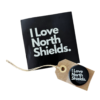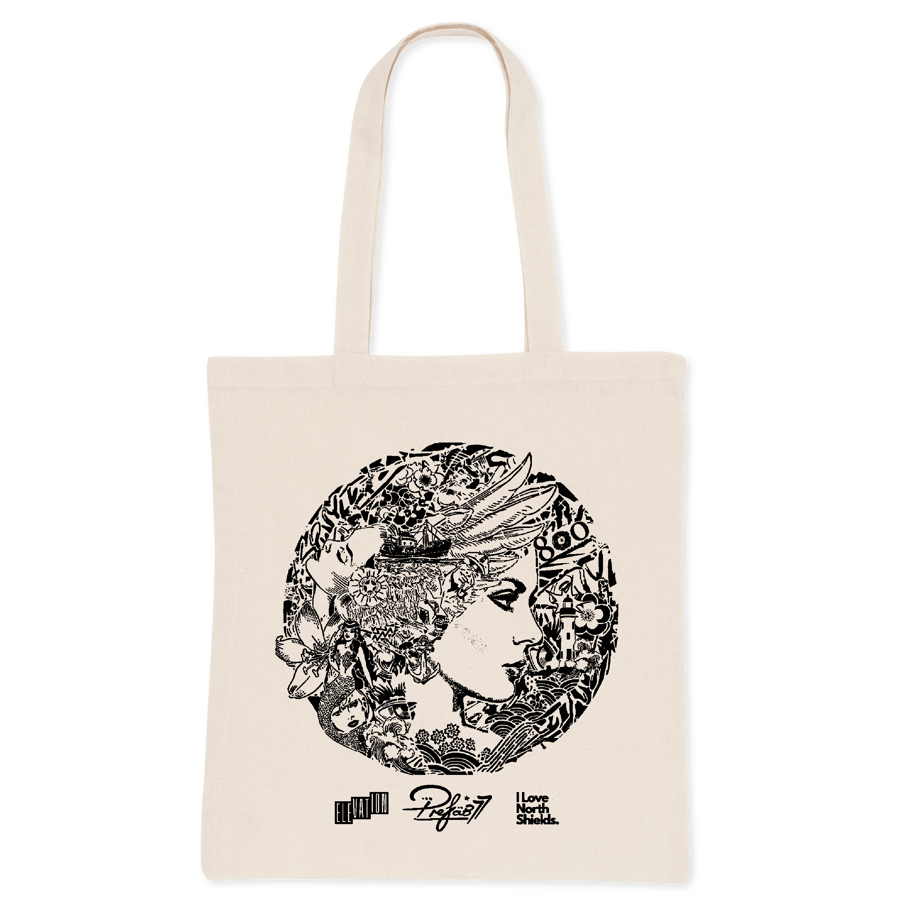Distance: 2.5 miles
Start & Finish: Fish Quay car park
Uncover the unique history and character of North Shields and discover how the town has grown from a tiny settlement in 1225 to the thriving area it is today.
Start: Fish Quay car park
Begin at the car park adjoining the gentle sweep of the Fish Quay sands, looking out towards the piers on both sides of the River Tyne.
Make sure to pick out the monumental statue of Newcastle-born Admiral Lord Collingwood, Nelson`s second in command at the Battle of Trafalgar, standing high on the north bank of the river.
Fiddler’s Green
Before you leave the immediate riverside behind, take a short walk past the shapely ice cream & coffee kiosk to the superb Fiddler`s Green Memorial, created by Ray Lonsdale and unveiled in September 2017, which honours the fishermen who died whilst doing their job after leaving the port of North Shields.
Lloyd’s Hailing Station
Ahead stand a series of semi-derelict wooden posts stretching out into the river, a popular resting place for any number of cormorants. This was once the walkway to Lloyd’s Hailing Station where a record was kept of the ships leaving and entering the River Tyne. Built in 1902 by Lloyds of London it was staffed by a worker who would shout to passing skippers, from a small hut at the extreme end of the walkway. The hailing station finally closed in 1969.
Head back as far as the large red marker buoy which was one of the devices used to indicate the safe channel for vessels arriving/leaving the port. The red ones were kept to the right of the vessel when arriving at the port and the green ones to the left of the vessel.
Former smokehouse
Now, turning to your left, walk past the intriguing former smokehouse, sitting on the 17th century walls of Clifford’s Fort, the most striking feature of which is the triple-glazed sea-facing frontage made from 40 curved van windscreens, which have been likened to the sails of a ship catching the wind.
Dolphin Mooring Post
When you reach the junction with Union Quay you will be standing beside the intriguing artwork called the Dolphin Mooring Post, created in 1993 by Freeform Artists and based on mooring staithes traditionally used on the River Tyne. This work, which includes a cormorant sitting on top drying its wings and affectionately known as Colin, was sculpted by artist Richard Broderick and was added some time after the main structure was installed.
Low Lights Tavern
Ahead is the steep Brewhouse Bank home to the late-18th century, Grade II Listed Low Lights Tavern, a popular watering hole and proud home to the two Brit Awards won by North Shields-born singer/songwriter Sam Fender.
Old Low Light
Head left into Union Quay and, within less than 100 metres, turn left alongside Vita House towards the gable end of the prominent three-storey building. Erected between 1727 and 1733, this building was the original Low Light (Old Low Light) which acted as a navigational aid to shipping entering the River Tyne.
It was converted to Almshouses in 1808. By the late 1980s this important landmark had fallen into a precarious state of disrepair but was saved from terminal decay by the joint efforts of the Tyne & Wear Building Preservation Trust and North Tyneside Council.
On your right, on a wall in front of the building, a blue plaque notes the existence, in this part of the Fish Quay, of Clifford`s Fort. Completed in 1672 to defend the River Tyne during the third Dutch War, the Fort was commanded by the Governor of Tynemouth Castle until 1839.
It acted as the headquarters of the Tyne Division of the Royal Engineers (Volunteers) from 1889 until 1928. The Old Low Light, which is also a Grade II Listed building, is now a Heritage Centre with a popular café inside.

Fish market
Retrace your steps back to Union Quay and, turning left continue towards the harbour and the covered fish market. Peep inside. The small harbour is no longer squeezed to bursting with a colourful array of fishing boats but the essence of the old Fish Quay remains.
High Light and Low Light
Look up to your left and see the impressive white painted façade of the new Low Light building. When aligned with the new High Light, to your right high on the top of the adjacent bank, this marked an entirely new channel for shipping to take when navigating the mouth of the river.
As you now continue along Union Quay keep a sharp eye out for a number of fishing industry themed decorative public artworks along this part of the river frontage. These include seating, bollards and street lights, all designed by Richard Broderick along with metal grilles in sections of the market area retaining wall depicting herring girls at work created by artist Maureen Black. Some of these are in need of some tender loving care.
This stretch of Union Quay is now home to a number of bars, restaurants and cafés which sit comfortably alongside the fish merchants who continue to sell their ‘harvests from the sea’.
Playwright Tom Haddaway
This is the heart of the Fish Quay, now a Conservation Area, where in 1937 North Shields-born playwright Tom Hadaway came to work as a 14 year old. He continued working in the fishing industry and used his experiences to write an excellent portfolio of plays including, The Filleting Machine, God Bless Thee Jackie Maddison, The Long Line and The Pigeon Man. He was also a contributor to the hugely popular TV series, When The Boat Comes In.
Herring Girl
Here a series of steep stairs traditionally linked the upper and lower parts of North Shields and when the bank side slum housing was eventually demolished a number of these stairs remained. You are still in Bell Street, so keep your eyes peeled towards the river and Western Quay where you will soon spot the life-size sculpture by Ray Lonsdale entitled, `Herring Girl’, which was officially unveiled by actress Brenda Blethyn in 2023.
In days gone by the herring girls played an important role on this bustling quay, following the route of the herring as they moved south, gutting and salting the fish that were caught and landed here.
Wooden Dolly
Then Bell Street leads into Liddell Street, with the Salt Market Social events building on your left and the new Riverside Embankment Walkway (nicknamed the Salt Market Walkway), and in little more than 200 metres you will come face to face with a large buxom female figure loitering outside the Prince of Wales Tavern.
Brightly painted in a red dress with a pink face and black hair, this armless Wooden Dolly was carved out of oak by Martyn and Jane Grubb and stands on the spot where a Wooden Dolly has traditionally stood since the early 1800s when a figurehead from the collier brig `Alexander and Margaret` was placed here.

Embankment
Wandering along Liddell Street it is difficult to believe that the embankments to your right were once heavily built up and housed, until the early 1930s, the majority of the population of North Shields. The new housing developments at Union Square, Swan Quay and Shepherd’s Quay have now repopulated a good part of the riverside, breathing new life into this old section of the town.
Where Liddell Street merges into Clive Street, the steep incline of Bedford Street rises to your right, following the course of an old stream. The bottom section of the street was once known as Wooden Bridge Bank.
Haddock Shop Dock
To your left is the old graving dock, known locally as the Haddock Shop Dock, used for many years to carry out repairs to lightships and other small vessels. Continue along Clive Street until you reach the Grade II Listed red brick former Porthole public house, once known as the Golden Fleece, now used for office purposes.
Built in 1897, and replacing an earlier public house on the site, the building was designed by Sunderland architects W & T.R. Milburn who designed a number of ornate theatres, including the Sunderland Empire Theatre.
New Quay and Market Place: The Jungle
Now cut straight across the bottom of Borough Road into the area of the riverside known as the New Quay and Market Place.
The foundation stone for the development of this area was laid on the 4th October 1806 by the Duke of Northumberland. Facing the river is the 1808 building, which for many years housed the notorious Northumberland Arms Inn, otherwise known to sailors worldwide as The Jungle.
The corner portion of the building, adjacent to Borough Road, was once a sailor’s home, and more recently a Customs House. A number of the buildings included in the scheme were never completed.
The Shields Ferry
To your left is the landing stage for the North Shields to South Shields ferry, a service which has been provided in some form since at least 1377.
On reaching the former Chain Locker public house, originally called the Crane Hotel whose historic glazed façade now forms the centre piece of a luxury apartment development, it is time to leave the immediate riverside.
Turn right, just beyond and behind the former Chain Locker, to climb the bankside via the stairs or the long ramp. Pause at the viewing balcony to look down to the river and on reaching the top continue right into Tennyson Terrace as far as the path between numbers 16 and 18.
St. Peter’s Church and School
Head across the footbridge which spans the deep cutting of Borough Road as it tumbles towards the river. On the left towards the bottom of the hill are the remnants of St. Peter’s Church and School which were both demolished in the 1930s slum clearance.
The church, commonly called the Sailor’s Church, was built in 1863 and occupied the lower part of the site at the bottom corner of Borough Road whilst the school, built in 1898, occupied the upper part of the site.
Over the bridge and again on terra firma continue along Yeoman Street passing, on the corner of Lower Rudyerd Street, the old Town Mission, and then on into Little Bedford Street.
Ignore both flights of stairs to your right, the first of which are called Grieves Stairs with the second flight named Tiger Stairs after the inn which once stood at the bottom, and continue as far as Saville Street.
Head right as far as the junction with Howard Street and then turn left in the direction of Northumberland Square. Keeping to the left hand side of Howard Street, first the John Dobson designed 1811 built Scotch Church, now home to the Salvation Army, is passed and then, a little further up, the Baptist Church of 1846, also by John Dobson.
Northumberland Square
The top of the street slips effortlessly into the fine and recently renovated Georgian Northumberland Square, described by Nikolaus Pevsner in his 1957 book `The Buildings of England: Northumberland`, as being “ a square almost too spacious for the two-storey houses that surround it”.
To your left is the 1960`s library. Walk clockwise around the square and admire the many fine buildings and, immediately before arriving back at the top of Howard Street, take a look at another of John Dobson`s buildings, St. Columba`s Presbyterian Church.
The church`s foundation stone was laid on 20th October 1856 by the then Independent Member of Parliament, William Shaw Lindsay and is designed in the Italian-style.
Architect: John Dobson
Born in Chirton, North Shields in 1787, John Dobson became the most noted architect in the North East of England. His partnership with the entrepreneur Richard Grainger helped change the face of Newcastle upon Tyne and gave the city some of the finest streets in England.
His influence on his town of birth can be clearly seen along the route of this walk and many of his other churches, country houses and neo-classical villas still grace the region.
Author: Rober Westall
Born in North Shields in 1929, Robert Westall found fame as the author of books such as ‘The Machine Gunners’, ‘Fathom Five’, ‘The Promise’, ‘Kingdom by the Sea’ and ‘Falling into Glory’.
References to many of the places visited in this walk can be found in his books.
MP: Thomas Burt
In 1874 Thomas Burt became one of the first working-class men to be elected a Member of Parliament. Born in North Shields in 1837 he started working in the coal mines at the age of 10, eventually rising to the position of Secretary of the Northumberland Miners Association. He became Father of the House of Commons in 1910.
The Exchange
Turn back into Howard Street and head down the left hand side. Just before you reach the junction with Saville Street be sure to examine the buildings which now make up the Exchange 1856, a “multi-functional business set at the heart of the North Shields Cultural Quarter”.
This is the old Town Hall and adjoining it is the former Methodist Church of 1856, with arched windows and a large gable.
Pop into the courtyard of the converted buildings and see the lovely stained glass window and plaque dedicated to North Shields war hero Thomas Brown. You might even want to stop off for a coffee and a cake.
Once outside again, cross over Saville Street and on the opposite corner you will see the former Public (Free) Library constructed in 1857-58.

Maritime Chambers
Now continue down Howard Street towards the small square in front of the beautiful Maritime Chambers. Now home to the local Registry Office, Maritime Chambers was completed in 1807 and originally housed the Tynemouth Literary and Philosophical Society`s Library before becoming the headquarters of the family run Stag Line shipping company.
The company`s stag emblem adorns the river facing gable wall of the building and, when erected, replaced the town`s official clock. Within the square itself there is a fine memorial to all those lost at sea, made from an old ship`s anchor, which was unveiled in 1999.
With Maritime Chambers behind you keep to the pavement which hugs the bank top along Tyne Street passing along the way the top of the Riverside Embankment Walkway, seen from below earlier in your walk.
Stand Laurel and Dockwray Square
Soon you will reach the modern buildings of Dockwray Square built around a formal park in the centre of which sits Robert Olley`s wonderful life size sculpture of Stan Laurel.
Born Arthur Stanley Jefferson in Ulverston in 1890, Stan moved to North Shields in 1897 when his father came to manage the Theatre Royal in Prudhoe Street. He continued to live in the now demolished 8 Dockwray Square until 1901 when he moved to Bishop Auckland.
The original Dockwray Square dates back to 1763 when it was laid out by Thomas Dockwray, vicar of Stamfordham. Whilst none of the original buildings remain, the rebuilt square reflects some of the style of the original houses.
In front of the square, clinging to the top of the bankside, is the 1807-built new High Light. Below you, on the left hand side of the High Light and down the first short flight of steps, is the Nater`s Bank Seascape.
Set into a steep slope this large environmental work is dominated by two huge cod frolicking among highly coloured fish and other creatures.
Designed by Maggie Howarth and sculpted by Richard Broderick and Graham Robinson, the work also contains smaller mosaic fish made by local school children.

Old High Light
Keep walking along Tyne Street and within 50 metres, at the beginning of the elegant Trinity Buildings, you will see the old High Light constructed in 1727 by Trinity House of Newcastle. This light succeeded several other similar lights which had been maintained in North Shields since as long ago as 1536 and both High Lights are now used as houses.
Continue alongside Trinity Buildings until you reach the former Wooden Doll public house, now called How Do You Do where you will see the head and shoulders Wooden Dolly which has been sitting outside the pub since the 1980s.
Before descending the stairs adjacent to the public house take note of the detail on the hand railings alongside the stairs. As with the seating, bollards and street lights seen earlier in the walk, this detail reflects the inseparable links between the town and the fishing industry. Sadly much of the detail has disappeared, perhaps stolen for its scrap value, since first installed.
Union Quay Stairs
Once at the bottom of Union Quay Stairs, turn left and you will see, once again, the artwork the Dolphin Mooring Post passed earlier in the day, and your way back to the car park via the route you took at the beginning of the walk.
As you start your journey home perhaps these lines from the poem Fish Quay1970 will help to capture a little of the spirit of your own personal North Shields Walk of Discovery;
The tackle of boys baiting
Halibut whiting catfish
Lines limp from quay
Caught between town and river
The cry and call of sea birds
Herring boats breaking water
Haul and catch
Squeezed into wet holds
The swish and slap of water
Load and unload














